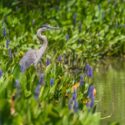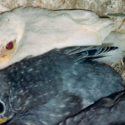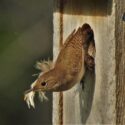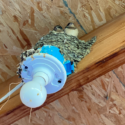 Photo ©
Keith Williams
Photo ©
Keith Williams

Small, Tall, We Archive Them All
Our Nest Quest Go! project continues to upload historical data into the NestWatch archives. Tree Swallows were added this month, increasing the number of nest records by 19,851! We also completed Great Blue Herons, which added 2,784 nest records to our database. These data spanned the years 1922–2010, contributing valuable historical information that scientists can now access. We are so grateful for the Nest Quest Go! volunteers who transcribed these data for posterity; we couldn’t do it without you.

NestWatcher Finds Rare Albino Bird
When a clutch of four Eastern Bluebird eggs in Wisconsin hatched this summer, NestWatcher Mary Roen was surprised to find that one of the nestlings was not like the others. As the pale nestling grew larger and more feathered, it became clear that this youngster had albinism, a genetic mutation that prevents its body from producing melanin.
Mary kept a close eye on the nest, monitoring it regularly for NestWatch as part of her long-term nest box monitoring efforts. The white-feathered bluebird grew up normally alongside its three siblings, with the only difference being that it fledged one day later than the others. Mary said of the experience, “This was the first time in my 34 years of bluebird monitoring that I had an albino bluebird.” Check out our Facebook post for more photos of the extremely rare chick.
Learn more about albinism in birds on the Project FeederWatch website.

Pennsylvania Data Preserved
We recently uploaded a 25-year dataset from Middle Creek Wildlife Management Area in Pennsylvania. The 5,567 records from 9 species certainly bolster our data for the region. We thank Brant Portner and Emma Hamaker for stewarding the data and preparing it for upload, as well as the many volunteers who collected the data over the past quarter-century. We’re glad you shared your records with the scientific community!

Dissertation Uses NestWatch Data
Congratulations to Murry Burgess for recently completing a doctoral dissertation entitled “The role of natural and artificial photoperiod on songbird physiology and development” at North Carolina State University. Murry utilized 58,192 nest records from NestWatch spanning from 2000–2019 to examine the influence of natural day length on Eastern Bluebird clutch sizes. The effects of artificial light at night on Barn Swallow nestling development were also investigated in a field study as part of Dr. Burgess’ dissertation.
The full study is available here, and includes some suggestions for how artificial light at night can be reduced.